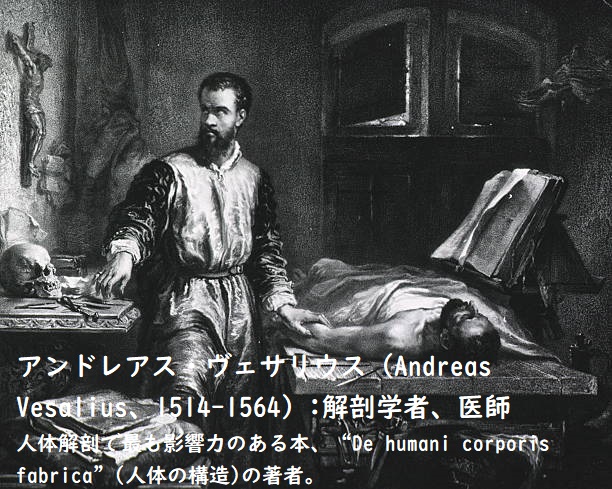
これまで見てきたように,中世時代を通して,病気の予防と治療は,迷信的あるいはまったく恣意的な(arbitary 原則によらず勝手な)方法で試みられた。解剖学及び生理学なしには(当時)より科学的なもの(予防や治療)はまったく不可能であり,そうしてこれらの科学も教会が反対する解剖を行なわないでは可能ではなかった。解剖学を初めて科学的なものにしたヴュサリウスは,皇帝チャールズ五世 -彼は自分が愛顧している医者を失ったら自分の健康は害されるかも知れないと恐れていた- の医者(侍医)だったので,暫くの間,公的な非難を首尾よく免れていた。チャールズ五世の治世下,神学者会議は,ヴュサリウスについて助言を求められ,彼らの意見として,解剖は神物冒涜(sacrilege 罰当たりな行為)ではないと回答した。しかし,(チャールズ五世ほど)病弱でないフィリップ二世は一人の被疑者(a suspect 嫌疑をかけられた者)を保護する理由を認めなかった。(そうして)ヴュサリウスはそれ以上解剖のための死体を得ることができなかった。キリスト教会(カトリック教会)は,人体の中には復活(再生)する肉体の核となる一つの(頑丈なため)破壊できない骨があると信じていた。ヴュサリウスは,そのことを問われ,そういった骨を未だかつて発見したことがないと告白した。これは具合わるいことだったが,おそらく,それほど悪いものではなかった。ガレヌス(Galen – Claudius Galenus, 129年頃 – 200年頃:ローマ帝国時代のギリシアの医学者で,彼の学説はルネサンスまでの1500年以上にわたり、ヨーロッパの医学およびイスラームの医学において支配的なものとなった) の医学上の弟子たちは -物理学においてアリストテレスがそうであったように,彼らは医学の進歩において大きな障害になった- ヴュサリウスを無慈悲な敵意をもって追求し,そして遂に(at length)彼を破滅させる機会を見出した。(即ち)彼が,親族の者の同意を得て某スペインの大公(grandee 最高位の貴族)の遺体を調べている時,(執刀用)ナイフの下で(その貴族の)心臓が動いている徴候を示しているのが観察された - あるいは彼の敵たちがそう言った。彼は殺人の罪の疑いがかけられ,異端審問所に告発された。王が影響力を行使することによって,彼は聖地への巡礼により懺悔する(罪の償いをする)ことを許された。しかし,巡礼からの帰路,彼は難破に遭い,岸に達したけれども,疲れ切って亡くなった。だが,彼の影響力は生き残った。即ち,彼の弟子の一人のファロッピオ(Fallopius = Gabriele Falloppio ガブリエレ・ファロッピオ, 1523-1562:イタリアの16世紀を代表する解剖学者で医師)は顕著な仕事をした。そうして,医療専門職たちは,徐々に,肉体のなかにあるものを発見する方法は(外から眺めるだけでなく,実際に)人体の中に存在するものを視線を向けて見る(look and see)ことだと確信するようになった。
Chapter 4: Demonology and Medicine, n.17
Throughout the Middle Ages, as we have seen, the prevention and cure of disease were attempted by methods which were either superstitious or wholly arbitrary. Nothing more scientific was possible without anatomy and physiology, and these, in turn, were not possible without dissection, which the Church opposed. Vesalius, who first made anatomy scientific, succeeded in escaping official censure for a while because he was physician to the Emperor Charles V, who feared that his health might suffer if he were deprived of his favourite practitioner. During Charles V’s reign, a conference of theologians, being consulted about Vesalius, gave it as their opinion that dissection was not sacrilege. But Philip II, who was less of a valetudinarian, saw no reason to protect a suspect ; Vesalius could obtain no more bodies for dissection. The Church believed that there is in the human body one indestructible bone, which is the nucleus of the resurrection body ; Vesalius, on being questioned, confessed that he had never found such a bone. This was bad, but perhaps not bad enough. The medical disciples of Galen – who had become as great an obstacle to progress in medicine as Aristotle in physics – pursued Vesalius with relentless hostility, and at length found an opportunity to ruin him. While, with the consent of the relatives, he was examining the corpse of a Spanish grandee, the heart – or so his enemies said – was observed to show some signs of life under the knife. He was accused of murder, and denounced to the Inquisition. By the influence of the king, he was allowed to do penance by a pilgrimage to the Holy Land ; but on his way home he was shipwrecked, and although he reached land he died of exhaustion. But his influence survived ; one of his pupils, Fallopius, did distinguished work, and the medical profession gradually became convinced that the way to find out what there is in the human body is to look and see.
出典:Religion and Science, 1935, chapt. 4:
情報源:https://russell-j.com/beginner/RS1935_04-170.HTM
